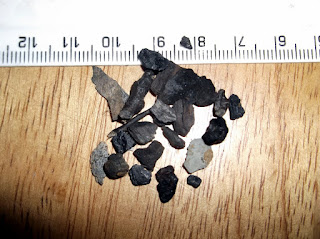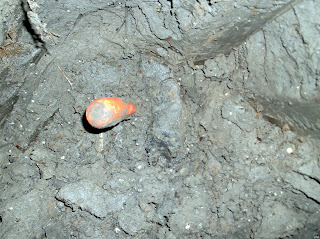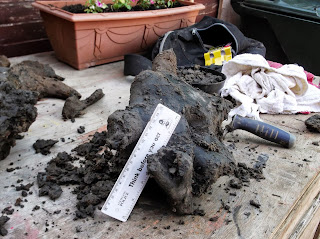- Clinker-built: The hull was constructed using a method where the edges of the planks overlapped, which is a style still used.
- Propulsion: They were versatile vessels that could be rowed with oars or sailed using a single mast and a square sail.
- Design: They were long, slender, and designed for speed, with a fairly flat midship section.
- Function: They were used for a variety of purposes, including warfare, trade, and exploration.
ANCIENT CLEVELAND - HISTORY OF A BECK
ANCIENT CLEVELANDS HIDDEN PAST.
Wednesday, 5 November 2025
Angle ships description
Thursday, 10 July 2025
The Angle defeat of the ninth legion in ancient Cleveland.
As stated before i believe the Angles held the high ground they named Cliffland aka Cleveland long before Rome arrived in other parts of Britain, they were recruited by Rome as long respected mercenaries and paid well for their defence of the North east, already settled in Cleveland and controlling the coast line Rome would have to respect their occupation of this land hence no known Roman military occupation of Cleveland
The image shows how the Angles would of appeared to any enemy, no wonder Rome decided to employ rather than fight them in the Cleveland hills. the Angles originated from the area we now call central Denmark and Southern Sweden, and could well have called Cleveland home long before Rome arrived in other parts of Britain, the Saxons however arrived long after this in the South of Britain and were a minority that had no dominance on the Angle lands, so the modern term Anglo Saxon is a myth and totally incorrect in describing our Ancestors as a whole.
Many place names in modern Cleveland can be found in the areas of what is now central Denmark and Southern Sweden including Middlebro meaning middle bridge - Saltholme - Ormeslev - Other Danish and southern Swedish place names that run almost parallel to Cleveland include, Vansbro - Alsterbro - Fellingsbro - Holestbro - Bjeringbro - Orebro - Aabro - Allingabro - Baekmarksbro - Sandsbro - Hobro - Landsbro - Asbro - The fact the Angles inhabited these areas of southern Sweden and central Denmark before landing in the area they named Cleveland the place name Middlebro in one of its past spellings can not be a coincidence.
Cleveland was and still is all the high ground North of Eoforwic that is said to be named by the Angles after Rome occupied Ebor the Ancient Briton name for the settlement. I believe the Angles reworded Ebor to their own words Eoforwic before Rome Arrived and that Eborcum only exists in Roman writings that were well edited. Ebor - Eoforwic - Yorvic, all relate to pigs - bore towns.
Recent archaeological finds in York point towards the Angles being their long before we thought, in fact the paper says the finds prove the Later great Danish Army was in fact returning home not invading as they landed in East Anglia and marched north to Eoforwic.
The Great Danish army as it was named landed in East Anglia among Angles with the same language and ancestry, they had in small ways been influenced by the corrupt church, but in essence were still Vikings. The march north to York was recorded by corrupt Saxon priests, so i will not go into that part of the story, the simple fact is they arrived at Eoforwic with no proven battle or resistance. Nothing is recorded of why the Army marched North to Eoforwic and not the so called beautiful south, and its riches and titles to be gained. I simply believe they were heading for the home from home.
Monday, 8 July 2024
Ancient Cleveland North East England
ANCIENT CLEVELAND
The area named Cleveland meaning Cliffland via old Norse, by the Angle's who came from what we now know as central Denmark and southern Sweden is I believe older than any other named area in England, the Angles visited the Cleveland coast long before Rome arrived in other parts of England, and ime certain the name was given on the earliest visits.
The Angles settled the area along with other parts of the north east of Britain and I believe the Cleveland area was used as home more than most, and the inlets of Whitby Staithes Skiningrove and the meandering delta of the river tees would of attracted the Angles both for access and defence., the Angles were very well known traders and warriors both to British tribes and the Romans in Europe, and well respected.
The Romans are known to have paid the Angles well for their services protecting the North east of Britain, I believe the Angle's retained the land they named Cleveland during the partial occupation by Rome and were hired from what was basically their own land within Britain i.e. Cleveland.
Eborcum - Eoforwic was only fifteen miles from this Angle land, both names basically mean Pig town, as did Yorvic, this is no surprise as the Angles and Danes were from the same part of what we now know as Denmark and southern Sweden.
Eborcum was the base of the infamous ninth legion, the ninth legion are recorded as setting off north to the Roman fort at Piercbridge on the Tees, no records exist of them arriving at the fort, the Angles are recorded as turning on Rome in Britain around this time, and I believe it was in Cleveland they turned on them during the march north to Piercbridge. The Angles then went on to dominate Britain and name a larger land than Cleveland called England.
Related - ANCIENT CLEVELAND - HISTORY OF A BECK: Search results for Ohio This link shows how Ancient Cleveland named Cleveland Ohio.
Wednesday, 20 March 2024
SORRY FOR THE ADVERTS I EARN NOTHING FROM THEM AND HOPE WITH HELP I CAN GET RID OF THEM SOON.
Tuesday, 13 February 2024
New inspection of the Stainsby beck sacrificial site 14 years later. I must apologise for the very long delay but ive had family priorities to take care of, but i will be revisiting this site in the summer of 2025.
This Easter holidays after 12 years i am returning to the Stainsby beck area where over 15 years i have excavated many ancient bones and artefacts, including human bones, from what is in my mind most certainly a prehistoric sacrificial site related to the exposure of the Cleveland Dyke. My findings after many floods will be posted soon after my visit. The two images below show the huge Cervus Elephus Antler piece and it excavation at the site from 12 years ago.
Thursday, 17 June 2021
Ancient Viking Cleveland
Cleveland’ is often mistakenly thought to be a modern invention. This confusion is due to the short-lived ‘County of Cleveland’ that existed for only 22 years (1974-1996) and included the former County Durham towns of Stockton; Hartlepool and Billingham to the north of the Tees.
Thursday, 12 November 2020
Ice dam collapse of the Esk valley
I believe i was right regarding the ice dam collapse at the western end of the Esk Valley being responsible for the superficial geology of the south western area of Cleveland. The central Esk water body if released suddenly would have created what we see today and would of destroyed most life including humans that had returned, I've already proven with the help of Andy Cooper tvrigs the area is not covered in till or boulder clay as stated by Agar and the Geological survey maps, it is in fact covered with alluvial deposits and complexed clays, that contain animal and human sub fossils.
Sunday, 20 September 2020
Thursday, 16 April 2020
Thursday, 25 April 2019
Prehistoric sacraficial site at Stainsby beck Cleveland North East England
I believe the area to be a prehistoric sacrificial site, that has close connections with the outcrop of the Cleveland Basaltic Andesite Dyke it surrounds.
I have excavated and discovered many well preserved mammal bones including Human in a very small area, situated around an outcrop of the dyke. None of the pieces show signs of butchery or disease. I have also excavated pottery pieces some with food remains still attached. Many of the skulls I have found have what look to be cavities and breaks caused by pieces of the basalt found close by.
In ten years of excavating these deposits I have never discovered any iron or alloy or traces of it.
I have also discovered a shoe after a partial collapse of one of my digs, that could well be part of the same deposits, all of the items listed below have been reported to Tees Archaeology and The Dorman Museum Middlesbrough without response. The Human bone has been examined and removed from my possession via Cleveland Police to Teesside University.
Below just some of the pieces excavated at the site, although I can not be certain the shoe sole came from the deposits, more information regarding the shoe sole find can be seen below.
Above a Human Tibia shaft outlined in red with a deer mandible is outlined in yellow to the right.
Above and below two Human Femurs found in the same area in the beck, almost certainly from the same deposits ive been excavating, the Femur above was said to be unusually long and robust in a report by Durham University.
Cervus Mandible





























































































































































